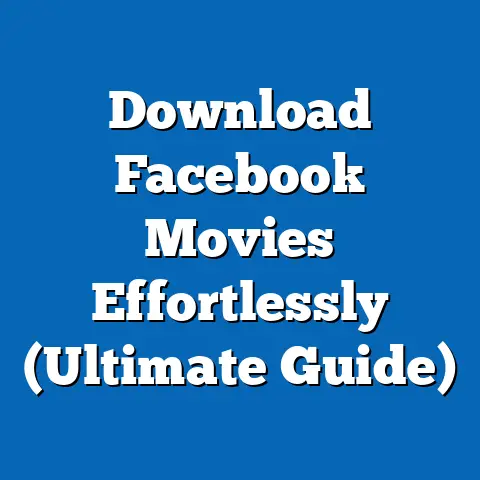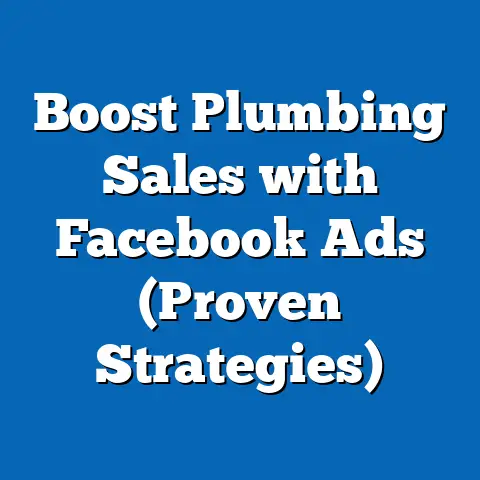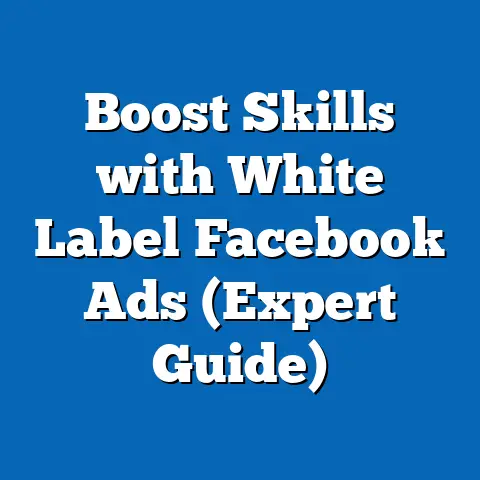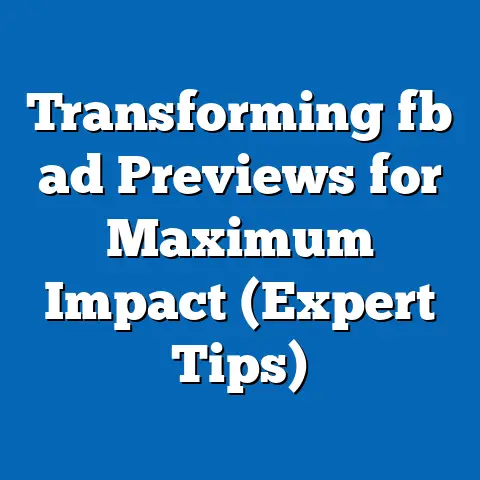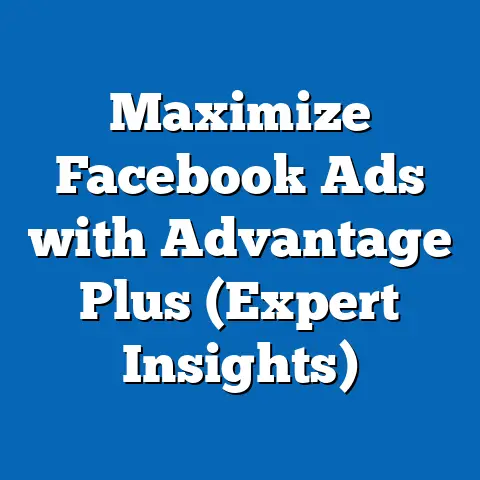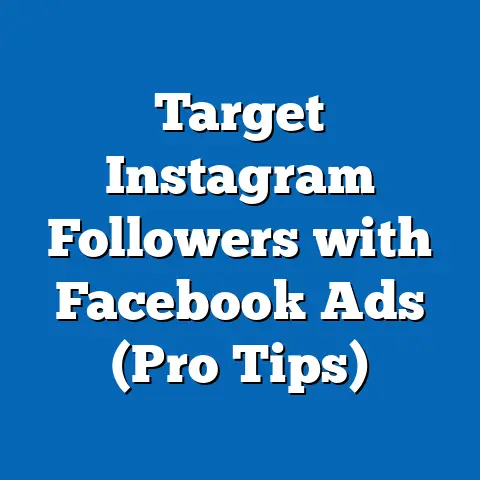Unlock the Best Facebook Ads Method (Proven Strategies)
I remember distinctly the day I met Alex, a small business owner, at a local marketing workshop. They were visibly stressed, their shoulders slumped, and their eyes held a mixture of desperation and a flicker of hope. Alex ran a handmade jewelry business, pouring their heart and soul into each unique piece. But despite their passion, their brand was struggling to get noticed amidst the overwhelming noise of the online marketplace.
Alex confided in me about the sleepless nights spent worrying about mounting bills, the gnawing anxiety of consistently low sales, and the relentless pressure to make their dream a reality. They had tried everything – organic social media, local craft fairs, even influencer collaborations – but nothing seemed to move the needle significantly.
Then, someone suggested Facebook ads. Alex was skeptical. They had heard horror stories of wasted ad spend and complex algorithms. Yet, desperation fueled a flicker of hope. Could this be the solution they were desperately searching for? This mixture of trepidation and optimism is something I’ve seen time and again in entrepreneurs embarking on the Facebook advertising journey. It’s a journey that can be both incredibly rewarding and incredibly frustrating.
My own journey started similarly. I remember feeling completely overwhelmed by the Ads Manager, the sheer number of targeting options, and the constant algorithm updates. I wasted money on poorly targeted campaigns and ads that simply didn’t resonate. But I learned, I adapted, and I eventually cracked the code.
This article isn’t just about the technical aspects of Facebook ads. It’s about connecting with your audience, telling your story, and building a brand that people genuinely care about. It’s about understanding the psychology behind effective advertising and the emotional triggers that drive conversions. It’s about taking control of your business’s destiny and achieving the success you deserve.
If you’ve ever felt the weight of a struggling business, the anxiety of low sales, or the frustration of ineffective marketing, then this guide is for you. I’m going to share proven strategies that have helped countless businesses, including Alex’s, transform their fortunes through the power of Facebook advertising. Get ready to unlock the best Facebook Ads method and take your business to the next level.
Section 1: Understanding Facebook Ads
1.1 The Power of Facebook Advertising
Facebook is no longer just a social networking platform; it’s a marketing juggernaut. With billions of active users worldwide, Facebook offers unparalleled reach and targeting capabilities for businesses of all sizes.
Let’s look at some numbers. As of early 2024, Facebook boasts over 3 billion monthly active users. That’s nearly half the world’s population! And these users aren’t just passively scrolling; they’re actively engaging with content, discovering new brands, and making purchasing decisions.
But it’s not just about the sheer size of the audience; it’s about the level of engagement. The average Facebook user spends a significant amount of time on the platform each day, providing ample opportunities for businesses to capture their attention and build relationships.
The real power of Facebook advertising lies in its ability to target specific demographics, interests, and behaviors. Unlike traditional advertising methods, which often rely on broad reach and hope for the best, Facebook allows you to pinpoint your ideal customer with laser precision.
I’ve seen firsthand the transformative impact that effective Facebook advertising can have on businesses. I recall working with a local bakery that was struggling to attract new customers. We crafted a targeted Facebook ad campaign highlighting their delicious pastries and running a limited-time promotion. Within weeks, the bakery saw a significant increase in foot traffic and online orders, ultimately revitalizing their business.
Another client, an online clothing boutique, was able to expand its reach beyond its local market by leveraging Facebook’s advanced targeting options. By identifying and targeting specific interest groups, we were able to reach potential customers across the country, resulting in a substantial increase in sales and brand awareness.
These are just a few examples of the countless success stories that I’ve witnessed. Facebook advertising, when done right, can be a game-changer for businesses of all types.
Key Takeaway: Facebook’s massive user base and advanced targeting capabilities make it a powerful platform for businesses seeking to reach their ideal customers and drive growth.
1.2 How Facebook Ads Work
Understanding the mechanics of Facebook’s advertising system is crucial for creating effective campaigns. The platform operates on a sophisticated auction-based system, where advertisers bid for the opportunity to display their ads to specific audiences.
Here’s a breakdown of the key components:
- Audience Targeting: As I mentioned earlier, Facebook’s targeting capabilities are incredibly granular. You can target users based on demographics (age, gender, location), interests (hobbies, passions, favorite brands), behaviors (purchase history, online activities), and much more.
- Ad Placements: Facebook offers a variety of ad placements, including the Facebook News Feed, Instagram Feed, Messenger, and Audience Network. Each placement has its own unique characteristics and best practices. For example, video ads tend to perform well in the News Feed, while image ads may be more effective in the right-hand column.
- Bidding Strategies: You have several bidding options to choose from, depending on your goals and budget. Common strategies include:
- Cost Per Mille (CPM): You pay for every 1,000 impressions your ad receives. This is a good option for brand awareness campaigns.
- Cost Per Click (CPC): You pay each time someone clicks on your ad. This is ideal for driving traffic to your website.
- Cost Per Action (CPA): You pay only when someone takes a specific action, such as making a purchase or filling out a form. This is the most cost-effective option for conversion-focused campaigns.
- Ad Quality: Facebook considers the quality of your ad when determining its ranking in the auction. High-quality ads are more likely to be shown to users and receive better results. Factors that influence ad quality include relevance, engagement, and overall user experience.
- Cost Per Mille (CPM): You pay for every 1,000 impressions your ad receives. This is a good option for brand awareness campaigns.
- Cost Per Click (CPC): You pay each time someone clicks on your ad. This is ideal for driving traffic to your website.
- Cost Per Action (CPA): You pay only when someone takes a specific action, such as making a purchase or filling out a form. This is the most cost-effective option for conversion-focused campaigns.
Understanding these elements allows me to create more effective campaigns for my clients. For example, if I’m running a brand awareness campaign, I’ll focus on maximizing reach and impressions using a CPM bidding strategy. On the other hand, if I’m trying to drive leads, I’ll optimize my ads for conversions and use a CPA bidding strategy.
Key Terminology:
- CPM (Cost Per Mille): The cost you pay for every 1,000 impressions your ad receives.
- CTR (Click-Through Rate): The percentage of people who see your ad and click on it.
- ROI (Return on Investment): The profit you generate from your advertising spend.
Key Takeaway: Facebook’s advertising system is based on an auction model where advertisers bid for ad placements based on targeting, bidding strategies, and ad quality. Understanding these elements is crucial for creating effective campaigns.
Section 2: Defining Your Goals
2.1 Setting Clear Objectives
Before you even think about creating your first Facebook ad, it’s essential to define your advertising goals. What do you want to achieve with your campaign? Are you trying to increase brand awareness, generate leads, drive sales, or something else entirely?
Setting clear objectives is crucial for several reasons:
- It provides direction: Clear goals give your campaign a clear sense of purpose and direction.
- It allows for measurement: Without clear goals, it’s impossible to measure the success of your campaign.
- It informs your strategy: Your goals will influence your targeting, ad creative, and bidding strategy.
I’ve seen many businesses make the mistake of launching Facebook ad campaigns without a clear understanding of what they want to achieve. This often leads to wasted ad spend and disappointing results.
Here’s a framework for aligning your business objectives with your Facebook ad campaigns:
- Identify your business goals: What are your overall business objectives? Are you trying to increase revenue, expand your customer base, or launch a new product?
- Translate your business goals into advertising goals: How can Facebook ads help you achieve your business goals? For example, if your business goal is to increase revenue, your advertising goal might be to drive sales through targeted product ads.
- Set specific, measurable, achievable, relevant, and time-bound (SMART) goals: Make sure your advertising goals are specific, measurable, achievable, relevant, and time-bound. For example, instead of saying “I want to increase sales,” set a goal like “I want to increase online sales by 20% in the next three months.”
Here are some common advertising goals and the corresponding Facebook ad strategies:
- Brand Awareness: Reach a large audience and increase brand visibility through engaging content and strategic targeting.
- Lead Generation: Collect leads through lead ads or by driving traffic to a landing page with a lead capture form.
- Website Traffic: Drive traffic to your website through compelling ad creative and targeted messaging.
- Sales/Conversions: Promote specific products or services and drive sales through conversion-optimized ads.
- App Installs: Encourage users to download your app through app install ads.
Key Takeaway: Setting clear, measurable, and achievable advertising goals is crucial for campaign success. Align your goals with your overall business objectives and choose the right Facebook ad strategies to achieve them.
2.2 Understanding Your Target Audience
Once you’ve defined your advertising goals, the next step is to understand your target audience. Who are you trying to reach with your ads? What are their demographics, interests, and behaviors? What are their pain points and aspirations?
Creating detailed buyer personas is essential for effective targeting and ad messaging. A buyer persona is a semi-fictional representation of your ideal customer, based on research and data about your existing customers and target market.
Here are some key elements to include in your buyer personas:
- Demographics: Age, gender, location, education, income, occupation.
- Interests: Hobbies, passions, favorite brands, online activities.
- Behaviors: Purchase history, website browsing habits, social media engagement.
- Pain Points: Challenges, frustrations, unmet needs.
- Aspirations: Goals, desires, dreams.
I’ve found that the more detailed and specific your buyer personas are, the more effective your targeting will be. Don’t just say “I want to target women aged 25-35.” Dig deeper and understand their motivations, their challenges, and their aspirations.
For example, let’s say you’re selling organic skincare products. Your buyer persona might look something like this:
- Name: Sarah
- Age: 30
- Occupation: Marketing Manager
- Location: San Francisco, CA
- Interests: Yoga, healthy eating, natural beauty products, sustainable living.
- Pain Points: Concerned about harsh chemicals in traditional skincare products, struggles with sensitive skin.
- Aspirations: Wants to maintain healthy, glowing skin using natural and sustainable products.
With this detailed buyer persona, you can create highly targeted Facebook ads that resonate with Sarah’s specific needs and interests. You can highlight the natural and organic ingredients in your products, address her concerns about sensitive skin, and position your brand as a solution for her desire to maintain healthy, glowing skin.
Audience Segmentation:
In addition to creating buyer personas, it’s important to segment your audience based on different characteristics. This allows you to tailor your ad messaging and targeting to specific groups of people.
For example, you might segment your audience based on:
- Age: Different age groups may have different interests and preferences.
- Location: People in different locations may have different needs and priorities.
- Purchase History: Customers who have previously purchased from you may be more receptive to targeted promotions.
- Website Activity: Users who have visited specific pages on your website may be interested in related products or services.
Key Takeaway: Understanding your target audience is crucial for creating effective Facebook ads. Develop detailed buyer personas and segment your audience to tailor your ad messaging and targeting for maximum impact.
Section 3: Crafting Compelling Ads
3.1 The Anatomy of a Successful Ad
Now that you’ve defined your goals and understood your target audience, it’s time to craft compelling Facebook ads that capture attention and drive action. A successful Facebook ad consists of several key components, working together to create a cohesive and persuasive message.
Here’s a breakdown of the anatomy of a successful ad:
- Visuals: The visual element of your ad is the first thing people will see, so it’s crucial to make it eye-catching and relevant. Use high-quality images or videos that showcase your product or service and capture the attention of your target audience.
- Headline: The headline is the first line of text people will read, so it needs to be attention-grabbing and concise. Use strong verbs and compelling language to pique their interest and encourage them to learn more.
- Ad Copy: The ad copy provides additional details about your product or service and explains why people should take action. Keep it concise, persuasive, and focused on the benefits for the customer.
- Call-to-Action (CTA): The CTA is the button or link that encourages people to take the next step, such as “Learn More,” “Shop Now,” or “Sign Up.” Use clear and compelling language that motivates people to click.
I’ve analyzed countless Facebook ads over the years, and I’ve found that the most successful ones share several common characteristics:
- Relevance: The ad is relevant to the target audience and their interests.
- Clarity: The message is clear, concise, and easy to understand.
- Value: The ad offers something of value to the customer, such as a discount, a free trial, or helpful information.
- Urgency: The ad creates a sense of urgency that motivates people to take action.
Let’s look at some examples of high-performing ads and analyze what makes them successful:
- Example 1: Shopify – Shopify frequently runs ads showcasing real-life entrepreneurs using their platform. The visuals are often authentic and relatable, the headline highlights the ease of starting an online business, and the ad copy focuses on the benefits of using Shopify. The CTA is typically “Start Free Trial,” which encourages people to try the platform risk-free.
- Why it works: This ad is successful because it taps into the aspirations of aspiring entrepreneurs and provides a clear and compelling solution.
- Example 2: Grammarly – Grammarly’s ads often feature humorous scenarios that highlight the importance of good writing. The visuals are engaging and entertaining, the headline is attention-grabbing, and the ad copy focuses on the benefits of using Grammarly to improve your writing skills. The CTA is typically “Get Grammarly,” which encourages people to sign up for the service.
- Why it works: This ad is successful because it uses humor to capture attention and highlights a common pain point (poor writing skills) that many people can relate to.
- Why it works: This ad is successful because it taps into the aspirations of aspiring entrepreneurs and provides a clear and compelling solution.
- Why it works: This ad is successful because it uses humor to capture attention and highlights a common pain point (poor writing skills) that many people can relate to.
Key Takeaway: A successful Facebook ad consists of compelling visuals, an attention-grabbing headline, persuasive ad copy, and a clear call-to-action. Focus on relevance, clarity, value, and urgency to maximize impact.
3.2 The Role of Creativity and Emotion
While the technical aspects of Facebook advertising are important, it’s equally crucial to understand the psychological aspects of advertising and how storytelling can foster emotional connections with your audience.
People don’t buy products or services; they buy emotions. They buy the feeling of confidence, the sense of belonging, or the satisfaction of solving a problem. Your Facebook ads should tap into these emotions and tell a story that resonates with your target audience.
I’ve found that the most effective Facebook ads are those that tell a story. Stories are powerful because they capture our attention, engage our emotions, and make us feel connected to the brand.
Here are some tips on creating visually appealing and emotionally resonant content:
- Use authentic visuals: Avoid stock photos and generic imagery. Use real photos and videos that showcase your brand’s personality and values.
- Tell a story: Craft a narrative that resonates with your target audience and highlights the benefits of your product or service.
- Focus on the customer: Make the customer the hero of your story and show how your product or service can help them achieve their goals.
- Use emotional language: Use words and phrases that evoke emotions and create a connection with your audience.
- Showcase social proof: Include testimonials, reviews, and case studies to build trust and credibility.
I remember working with a local non-profit organization that was struggling to raise funds for their cause. We crafted a Facebook ad campaign that told the story of a beneficiary whose life had been transformed by the organization’s work. The visuals were authentic and emotional, the headline was attention-grabbing, and the ad copy focused on the impact that donations could have on people’s lives. The campaign was incredibly successful, raising a significant amount of money for the organization and increasing awareness of their mission.
Key Takeaway: Tap into the emotions of your target audience and tell a story that resonates with them. Use authentic visuals, emotional language, and social proof to create a connection and drive action.
Section 4: Proven Strategies for Success
4.1 A/B Testing and Optimization
A/B testing, also known as split testing, is the process of comparing two versions of an ad to see which one performs better. This is a crucial step in optimizing your Facebook ad campaigns and maximizing your ROI.
The basic idea behind A/B testing is to create two versions of an ad that are identical except for one key element. For example, you might test two different headlines, two different images, or two different calls-to-action.
By running both versions of the ad simultaneously and tracking their performance, you can determine which element resonates best with your audience and make data-driven decisions about which ad to use.
I’ve found that A/B testing is one of the most effective ways to improve the performance of my Facebook ad campaigns. It allows me to identify the elements that are working well and the elements that need improvement, and make adjustments accordingly.
Here’s a step-by-step guide on how to conduct effective A/B tests:
- Identify the element you want to test: Choose one element of your ad to test, such as the headline, image, ad copy, or call-to-action.
- Create two versions of the ad: Create two versions of the ad that are identical except for the element you’re testing.
- Set up your A/B test: Use Facebook Ads Manager to set up your A/B test. You can either create two separate ad sets or use Facebook’s built-in A/B testing tool.
- Run your test: Run your A/B test for a sufficient amount of time to gather statistically significant data.
- Analyze the results: Analyze the results of your A/B test to determine which version of the ad performed better.
- Implement the winning version: Implement the winning version of the ad and continue to monitor its performance.
Interpreting Results:
When analyzing the results of your A/B test, pay attention to the following metrics:
- Click-Through Rate (CTR): Which version of the ad had a higher CTR?
- Conversion Rate: Which version of the ad had a higher conversion rate?
- Cost Per Click (CPC): Which version of the ad had a lower CPC?
- Cost Per Conversion (CPA): Which version of the ad had a lower CPA?
Key Takeaway: A/B testing is a crucial step in optimizing your Facebook ad campaigns. Test different elements of your ads to determine what resonates best with your audience and make data-driven decisions about which ads to use.
4.2 Utilizing Facebook Pixel for Retargeting
The Facebook Pixel is a small snippet of code that you place on your website to track user behavior. It allows you to track which pages people visit, which products they view, and which actions they take on your site.
This information is invaluable for retargeting, which is the process of showing ads to people who have previously interacted with your brand. Retargeting is one of the most effective strategies for driving conversions and increasing ROI.
I’ve seen firsthand the power of retargeting. I worked with an e-commerce client who was struggling to convert website visitors into paying customers. We implemented the Facebook Pixel and created retargeting ads that showed users the products they had previously viewed on the site. The results were dramatic. The client saw a significant increase in conversions and a substantial boost in revenue.
Here are some strategies for retargeting ads to re-engage users who have previously interacted with your brand:
- Website Visitors: Show ads to people who have visited your website but haven’t made a purchase.
- Product Viewers: Show ads to people who have viewed specific products on your website.
- Add to Cart Abandoners: Show ads to people who have added products to their cart but haven’t completed the checkout process.
- Past Customers: Show ads to people who have previously purchased from you.
Key Takeaway: The Facebook Pixel is a powerful tool for tracking user behavior on your website and retargeting ads to re-engage users who have previously interacted with your brand. Retargeting is one of the most effective strategies for driving conversions and increasing ROI.
4.3 Leveraging Lookalike Audiences
Lookalike audiences are a powerful way to find new potential customers who are similar to your existing customers. Facebook uses its vast database of user information to identify people who share similar demographics, interests, and behaviors with your best customers.
This allows you to expand your reach beyond your existing audience and target people who are more likely to be interested in your products or services.
I’ve used lookalike audiences extensively in my Facebook ad campaigns, and I’ve consistently seen great results. I worked with a SaaS company that was looking to expand its customer base. We created a lookalike audience based on their existing customer data and targeted them with ads highlighting the benefits of their software. The campaign was incredibly successful, generating a large number of new leads and customers.
Here’s how to create a lookalike audience:
- Create a source audience: Choose a source audience to base your lookalike audience on. This could be your existing customer list, website visitors, or people who have engaged with your Facebook page.
- Choose a lookalike size: Choose the size of your lookalike audience. A smaller audience will be more similar to your source audience, while a larger audience will be less similar.
- Create your lookalike audience: Facebook will use its data to identify people who are similar to your source audience and create your lookalike audience.
Key Takeaway: Lookalike audiences are a powerful way to find new potential customers who are similar to your existing customers. Use this strategy to expand your reach and target people who are more likely to be interested in your products or services.
4.4 Harnessing Video Content
Video ads are becoming increasingly popular on Facebook, and for good reason. They’re highly engaging, visually appealing, and can be incredibly effective at capturing attention and driving action.
According to recent statistics, video ads have a higher click-through rate and conversion rate than image ads. They’re also more likely to be shared and commented on, which can help to increase brand awareness and reach.
I’ve seen the power of video ads firsthand. I worked with a local restaurant that was looking to attract new customers. We created a short video showcasing their delicious food and inviting people to come and dine. The video was incredibly successful, generating a large number of new customers and increasing revenue.
Here are some tips on creating impactful video content that tells a story and drives action:
- Keep it short and sweet: People have short attention spans, so keep your video ads concise and to the point.
- Grab attention quickly: Capture attention in the first few seconds of your video.
- Tell a story: Craft a narrative that resonates with your target audience and highlights the benefits of your product or service.
- Use visuals: Use high-quality visuals that are engaging and visually appealing.
- Include a call-to-action: Tell people what you want them to do.
Key Takeaway: Video ads are a powerful way to engage your audience, capture attention, and drive action. Use impactful video content that tells a story and highlights the benefits of your product or service.
Section 5: Budgeting and Analytics
5.1 Setting an Advertising Budget
One of the most common questions I get asked is, “How much should I spend on Facebook ads?” The answer, of course, depends on a variety of factors, including your business goals, your target audience, and your budget.
However, there are some general guidelines you can follow to determine an appropriate budget for your Facebook ads.
- Start Small: If you’re new to Facebook advertising, it’s best to start with a small budget and gradually increase it as you see results.
- Consider Your Goals: Your budget should be aligned with your advertising goals. If you’re trying to increase brand awareness, you may need a larger budget to reach a wider audience. If you’re trying to drive sales, you can start with a smaller budget and focus on optimizing your ads for conversions.
- Calculate Your ROI: Track your results closely and calculate your ROI. This will help you determine whether your advertising spend is generating a positive return.
Bidding Strategies:
Facebook offers several bidding strategies, including:
- Automatic Bidding: Facebook automatically sets your bids to get the most results for your budget.
- Manual Bidding: You set your bids manually.
Key Takeaway: Set a budget that aligns with your advertising goals and track your results closely to calculate your ROI.
5.2 Analyzing Ad Performance
Analyzing your ad performance is crucial for optimizing your campaigns and maximizing your ROI. Facebook Ads Manager provides a wealth of data that you can use to monitor and analyze the success of your campaigns.
Here are some key metrics to track:
- Impressions: The number of times your ad was shown.
- Reach: The number of unique people who saw your ad.
- Click-Through Rate (CTR): The percentage of people who saw your ad and clicked on it.
- Cost Per Click (CPC): The cost you pay each time someone clicks on your ad.
- Conversion Rate: The percentage of people who clicked on your ad and completed a desired action, such as making a purchase or filling out a form.
- Cost Per Conversion (CPA): The cost you pay for each conversion.
- Return on Ad Spend (ROAS): The revenue you generate for every dollar you spend on advertising.
Key Takeaway: Track your ad performance closely using Facebook Ads Manager and use the data to optimize your campaigns and maximize your ROI.
Section 6: Staying Ahead of the Curve
6.1 Keeping Up with Facebook Algorithm Changes
Facebook’s advertising algorithm is constantly evolving, so it’s essential to stay informed about updates and changes to the platform. This will help you adapt your strategies and avoid being penalized by the algorithm.
Here are some strategies for staying up-to-date with Facebook algorithm changes:
- Follow Facebook’s official blog: Facebook regularly publishes updates and announcements on its official blog.
- Read industry news and blogs: Stay informed about the latest trends and best practices in Facebook advertising.
- Attend industry events: Network with other marketers and learn from their experiences.
- Experiment and test: Continuously experiment with new strategies and techniques to see what works best for your business.
Key Takeaway: Stay informed about updates and changes to Facebook’s advertising algorithm and adapt your strategies accordingly.
6.2 Exploring Future Trends in Facebook Advertising
The world of digital advertising is constantly evolving, and it’s important to stay ahead of the curve by exploring future trends and emerging technologies.
Here are some emerging trends in digital advertising:
- Augmented Reality (AR) Ads: AR ads allow users to interact with your products or services in a virtual environment.
- Artificial Intelligence (AI): AI is being used to automate tasks, personalize ads, and improve targeting.
- Personalization: Customers expect personalized experiences, so it’s important to tailor your ads to their individual needs and interests.
Key Takeaway: Explore future trends and emerging technologies to stay ahead of the curve in digital advertising.
Conclusion: The Journey to Success
Remember Alex, the small business owner I mentioned at the beginning? Well, after implementing the proven strategies I’ve discussed in this article, their business experienced a remarkable turnaround.
They started by defining clear advertising goals and creating detailed buyer personas. They crafted compelling ads that told a story and resonated with their target audience. They implemented the Facebook Pixel and retargeted users who had previously interacted with their brand. They leveraged lookalike audiences to find new potential customers. And they analyzed their ad performance closely and made adjustments as needed.
The results were transformative. Alex’s online sales increased by 50% in just three months. They were able to expand their customer base and reach new markets. And, most importantly, they regained their confidence and passion for their business.
Alex’s story is a testament to the power of Facebook advertising when done right. It’s not just about the numbers; it’s about connecting with your audience and telling your brand’s unique story.
Success in Facebook advertising is not just about the numbers; it’s about connecting with your audience and telling your brand’s unique story. It’s about taking control of your business’s destiny and achieving the success you deserve.
So, take the first step on your journey towards unlocking the best Facebook ads method. Remember that every great success begins with action. Start today, and you’ll be well on your way to achieving your advertising goals and transforming your business. I’m confident that with the strategies I’ve shared, you can unlock the full potential of Facebook advertising and achieve the success you deserve. Good luck!

